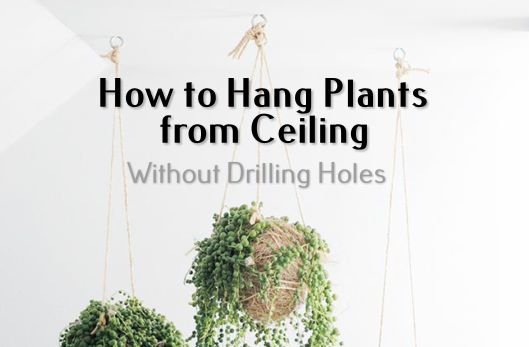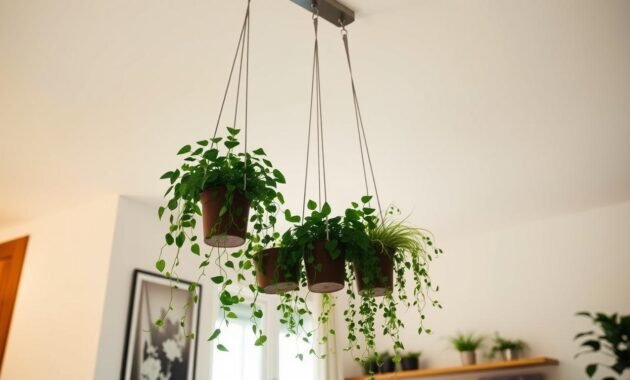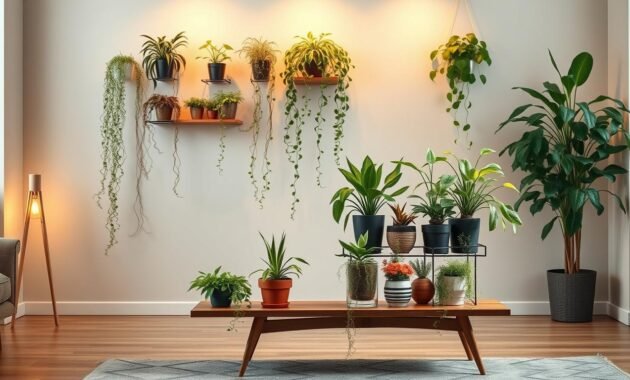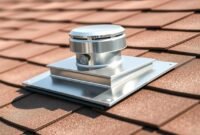Are you having trouble showing off your favorite plants without harming your ceiling? Living in a rented place or fearing permanent marks can make it seem like hanging plants is out of the question. Traditional ways often mean drilling holes, which can hurt your deposit and the walls.
I’ll share clever ways to hang plants from your ceiling without drilling. These methods will turn your space into a beautiful green oasis. You’ll learn how to decorate with plants without damaging your walls or breaking your rental rules. Get set to discover easy, safe ways to make your indoor space look amazing!
Read also: How to Hang Plants from Ceiling without Drilling Holes

Why Consider Hanging Plants Without Drilling
Setting up an indoor garden can be tough, mainly because you don’t want to harm your home. No-drill plant holders are a great fix for those who love plants but don’t want to damage their walls.
Hanging plants can turn any room into a lively green oasis. The best part about no-drill methods is how easy and versatile they are. They work well for both renters and homeowners, bringing many benefits.
- Protect walls and ceilings from permanent damage
- Maintain rental security deposits
- Create flexible plant display options
- Avoid costly repair expenses
Benefits for Renters and Homeowners
Renters have special challenges when decorating. Traditional hanging methods often mean drilling, which can cost a lot or hurt your deposit. No-drill solutions let you decorate without worrying about damage.
Protecting Your Security Deposit
Landlords can be strict about making changes to walls and ceilings. No-drill plant holders are a safe choice. They let you have a beautiful indoor garden without risking your deposit.
Maintaining Ceiling Integrity
Keeping your home’s structure intact is key. No-drill plant holders help avoid holes and damage. They also let you change your plant setup whenever you feel like it.
Essential Preparation Before Hanging Plants
Before you start hanging your indoor plants, it’s important to prepare well. Knowing the weight of your plants and picking the right pots is key. This will make your hanging plant journey a success.
First, get the tools you need for plant preparation:
- Digital kitchen scale
- Measuring tape
- Notebook for tracking plant weights
- Watering can
To figure out the weight of your plants and pots, follow these steps:
- Water your plant well
- Wait 15 minutes for water to drain
- Weigh the plant and its pot together
- Write down the total weight
| Plant Type | Average Weight (Wet) | Recommended Hanging Method |
|---|---|---|
| Small Succulent | 1-2 lbs | Adhesive Hooks |
| Medium Pothos | 3-5 lbs | Tension Rods |
| Large Ficus | 6-10 lbs | Heavy-Duty Magnetic Hooks |
Pro tip: Always add 20% to your weight calculations. This extra buffer ensures your hanging setup can safely hold your plants and pots. It helps avoid accidents or damage to your ceiling.
How to Hang Plants From Ceiling Without Drilling
Adding greenery to your home doesn’t mean you have to damage your ceiling. I’ve found creative ways to hang plants without drilling. These methods can change any room without harming your walls or ceiling.
Hanging plants can be a challenge. But, with the right tools, you can make a beautiful indoor garden. Use ceiling plant hooks that don’t need to be installed permanently.
Weight Considerations for Plant Selection
Not all plants are good for hanging. Choose light ones that won’t pull too hard on your hanging setup:
- Pothos (trailing varieties)
- Spider plants
- String of pearls
- Small ferns
Read also: How to Hang a Ceiling Fan without a Stud on Light Fixture Spot
Best Locations for Hanging Plants
Finding the right spot for your hanging planter is key. Look for areas with:
- Indirect natural light
- Stable ceiling surfaces
- Away from high-traffic zones
- Near windows but not in direct sunlight
Safety Precautions to Consider
Always put safety first when setting up ceiling plant hooks. Avoid hanging plants:
- Near electrical fixtures
- Over valuable furniture
- In areas with frequent foot traffic
- Close to fire alarms or sprinkler systems
Do a weight check before hanging. Use multiple points for heavy planters. Make sure your hanging method is strong before placing your plant.
Using Adhesive Hooks for Plant Display
Adhesive hooks are a game-changer for hanging plants without damage. They let you hang lightweight plants without holes in your ceiling. The trick is to pick the right hooks and apply them right.
When picking adhesive hooks, remember these important points:
- Select hooks made for ceiling use
- Make sure the surface is clean and dry
- Check the weight limit carefully
- Use them only for light plants
My best advice is to prepare well. Clean the ceiling with rubbing alcohol to remove dust or oils. This boosts the hook’s adhesive power. Most hooks can hold up to one pound, ideal for small plants like pothos or spider plants.
Always test a hook before using it. Apply it to a small, hidden spot first. Make sure it holds well and doesn’t harm the surface. Some brands promise no damage when removed, great for renters or those who care about their ceiling.
With the right hooks and light plants, you can change your space without harm. Just be careful, follow the instructions, and enjoy your hanging plants!
Magnetic Solutions for Ceiling Plant Hanging
Looking for new ways to show off your plants without harming your ceiling is exciting. Magnetic ceiling plant hooks are a smart choice for those who want no-drill options. They offer both flexibility and strength.
Magnetic hooks are great for hanging plants in areas with metal surfaces. They make indoor gardening better without damaging your ceiling.
Finding the Right Metal Surfaces
Finding the right metal spots is key for magnetic plant hangers. Here are some top places to look:
- Exposed metal beams
- Dropped ceilings with metal grids
- Metal air ducts and vents
Understanding Weight Capacity
Not all magnetic hooks are the same. Always check the weight limit before hanging plants. Each hook has its own limit to keep things safe.
Installation Tips for Magnetic Hooks
To find metal spots, use a small magnet on the ceiling. This helps find where to hang your no-drill plant holders. When you install, make sure:
- The surface is clean and dry
- The magnetic hook can hold your plant’s weight
- The hook is well attached before you hang
Magnetic ceiling plant hooks are a stylish, safe way to hang plants. They let you create beautiful vertical gardens without harming your space.
Tension Rod Methods for Plant Suspension

Tension rods are a great way to hang plants without harming walls or ceilings. They are perfect for small spaces or near windows. This method is smart and easy to use.
I found that tension rods are ideal for unique plant displays. They make indoor gardening easy, working well in apartments, rental homes, and permanent places.
- Choose adjustable tension rods that extend between two walls
- Select rods slightly longer than your intended space for secure installation
- Use multiple hooks to distribute plant weight evenly
- Consider vertical and horizontal configurations for creative displays
My top trick is to make a freestanding plant station. Use two vertical rods and a horizontal one at the top. This lets you place your plants anywhere without fixing them.
Remember to check the weight limit of your tension rod. Also, use rubber tips to avoid scratching walls. Lighter plants are best for this method, making your display both safe and stylish.
Creative Solutions with Suction Cup Hooks
Suction cup hooks are a great way to hang plants indoors without damaging walls. They are perfect for places where you can’t use regular hooks. These hooks let you show off your plants without leaving marks on surfaces.
Ideal Surfaces for Suction Cup Application
Suction cup hooks work best on smooth surfaces. I’ve found they work great on:
- Glass windows and skylights
- Smooth ceramic tiles
- Polished plastic surfaces
- Clean mirror surfaces
Weight Limitations and Best Practices
Using suction cups for hanging plants has taught me a lot. Always pick high-quality suction cups that can hold your plant’s weight. Lighter plants are best for this method.
Before you start, make sure to:
- Clean the surface well
- Make sure it’s dry
- Press the suction cup hard
- Check the hook’s strength often
Pro tip: For heavier plants, use more suction cups. This spreads the weight and makes your plants look great while keeping your surfaces safe.
Installing Bar Clamps and C-Clamps for Plants
I found a cool way to hang plants without harming your ceiling. You can use bar clamps and C-clamps as plant hangers. These tools are great for those who don’t want to drill holes.
Bar clamps are awesome for making flexible plant hooks. You can move plants along a metal rail. This lets you place plants wherever you want. Most bar clamps are 36 or 48 inches long, so you can hang many plants.
- Choose bar clamps with sturdy metal construction
- Look for clamps with padded ends to protect surfaces
- Select adjustable models for maximum flexibility
C-clamps are perfect for spots with exposed beams. They hold tight without damaging anything. This makes them great for renters or anyone who doesn’t want to mark their ceiling.
Pro tip: Use a soft cloth or rubber pad between the clamp and your surface. This prevents scratches and keeps your ceiling safe.
Remember to think about your plants’ weight when choosing hooks. Lighter plants are best for these methods. This ensures they hang safely and securely.
Selecting Lightweight Plants and Containers
Choosing the right plants and planters for hanging is key. It’s all about keeping things light and looking good. This way, your ceiling plants will be a hit.
Looking for the perfect plants for your hanging planter? Here are some top picks:
- Air plants: They’re almost weightless and don’t need soil.
- String of pearls: This succulent is light and trails beautifully.
- Pothos: It’s a light vine that grows down.
- Spider plants: They’re small, light, and have pretty tendrils.
- Tillandsia: They have a small root system and are very light.
Choosing Ideal Hanging Planters
For hanging planters, go for light materials. Options like plastic, fiberglass, and natural fibers are great. They’re perfect for hanging without drilling.
- Plastic containers: They look heavy but are really light.
- Coconut coir baskets: They have a natural look and are light.
- Clear glass globes: Great for air plants and small succulents.
- Lightweight ceramic alternatives: They look like ceramic but are made of resin.
Don’t forget that plants get heavier when they’re watered. Pick a hanging method that can handle a bit more weight. This ensures your plants stay stable over time.
Alternative Hanging Methods Using Furniture
Furniture can be a surprising ally in your indoor plant decor. I’ve found clever ways to turn everyday furniture into beautiful plant displays. These add life and character to any room.

Clothing racks are a top pick for plant enthusiasts looking for flexibility. They offer strong support for hanging plants and can be moved easily. This is great for small apartments or studios where space is limited.
- Clothing Rack Plant Display: Hang lightweight planters at different heights for a dynamic green installation
- Bookcase Ladder Plants: Use ladder rungs as natural plant hangers for an industrial-chic look
- Coat Rack Transformation: Convert a simple coat rack into a vertical garden with carefully selected hanging planters
Pipe shelving units are another creative option for indoor plant decor. Use S-hooks to hang plants at different levels. This creates a unique look that’s also functional art. It’s ideal for renters who want to decorate without damaging the space.
Make sure to think about the weight of your plants. Choose furniture that can hold them safely. Lighter plants and smaller containers work best for these creative mounting ideas.
Maintenance Tips for Hanging Plants
Keeping hanging planters in top shape is key to a vibrant indoor space. It’s not just about watering. It’s about using the right care techniques.
Watering is a skill you need for hanging plants. Here are some tips:
- Use a long-spouted watering can to prevent messy spills
- Consider self-watering hanging planters for consistent moisture
- Check soil moisture before each watering
- Adjust watering frequency based on plant species and indoor environment
Managing the weight of your plants is also important. As they grow, they can get too heavy. Here’s what I do:
- Inspect hanging hardware for stability
- Prune plants to control size and weight
- Rotate plants to ensure even growth
- Replace containers if they become too heavy
Light and humidity are also key for your plants. I place them where they get the right light. I also clean leaves, check for pests, and fertilize them sometimes. This keeps my plants looking great and healthy.
Conclusion
Learning how to hang plants from the ceiling without drilling has been exciting. It has shown us many creative ways to decorate with plants in apartments. We’ve found many innovative methods that let us decorate without harming walls or ceilings.
We’ve talked about different ways to hang plants, like adhesive hooks, magnetic solutions, and tension rods. Each method has its own benefits. They work well for renters who don’t want to damage their walls and for homeowners who want to decorate easily.
Read also: Top Best Strong Magnetic Strips
I love how these no-drill methods give us freedom. We can try out different plant setups, change containers, and rearrange our spaces easily. With the right plants and hanging tools, anyone can make a beautiful indoor garden that looks great and feels personal.
But, to have a successful indoor garden, we need to plan carefully and take care of it regularly. By picking the right methods and knowing how much weight they can hold, we can make a lively green space. This space will make our homes better without hurting our walls or breaking any rental rules.


